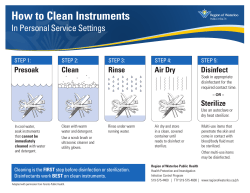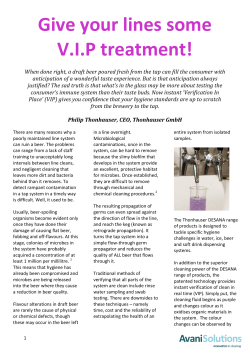
Reusable Instrument Care Manual Manufacturer Ortho Development® Corporation 12187 South Business Park Drive
Reusable Instrument Care Manual Balanced Knee® System, BKS TriMax™, and Balanced Knee® Revision System Manufacturer Ortho Development® Corporation 12187 South Business Park Drive Draper, UT 84020 Phone 801-553-9991 Fax 801-553-9993 www.orthodevelopment.com INSTRUMENT CARE Considerations This guide includes processing instructions for all Ortho Development® reusable devices only. New and used instruments must be thoroughly cleaned per these instructions prior to sterilization and use. Warnings and Precautions • Universal precautions should be observed by all hospital personnel that work with contaminated medical devices. Caution should be exercised when handling devices with cutting edges or sharp points. • Personal protective equipment (PPE) should be worn when handling or working with contaminated or potentially contaminated devices. PPE includes gown, mask, goggles or face shield, gloves and shoe covers. • Do NOT place heavy instruments on top of more delicate instruments. • Do NOT use metal brushes or scouring pads during manual cleaning. These will damage the surface and finish of instruments. Only soft-bristled, nylon brushes and pipe cleaners should be used. • Do NOT allow contaminated instruments to dry prior to reprocessing. All subsequent cleaning is facilitated by not allowing blood, body fluid, bone and tissue debris, saline or disinfectants to dry on used instruments. • Saline, and cleaning/disinfection agents containing active chlorine, aldehyde, bromide, bromine, chloride, mercury, iodine or iodide are corrosive and should NOT be used. • Mineral oil or silicone lubricants should not be used because they are difficult to remove, prevent direct contact of the surface with steam during sterilization and coat microorganisms. Limitations and Restrictions • Automated cleaning using a washer/disinfector alone may not be effective for cleaning orthopedic instruments. A thorough manual or combination manual/automated cleaning process is recommended. • Neutral pH enzymatic and cleaning agents are recommended. • Instrument trays, cases and lids must be cleaned separately. Non-sterile, single use implants are an exception as they may remain in the tray or caddy for reprocessing. • Repeated processing has minimal effect on Ortho Development reusable instruments unless otherwise noted. End of life for stainless steel or other metal surgical instruments is normally determined by wear and damage due to the intended use and not reprocessing. • Use of hard water should be avoided. Softened tap water may be used for initial rinsing. Reverse Osmosis (RO) or Deionized (DI) water should be used for final rinsing of the instruments. CLEANING INSTRUCTIONS Point of Use Remove excess body fluids and tissue from instruments with a disposable, non-shedding wipe. Place devices in a tray of distilled water or cover with damp towels. Instruments should be cleaned within 30 minutes of use to minimize the potential for drying prior to cleaning. Used instruments must be transported to the central supply in closed or covered containers to prevent unnecessary contamination risk. Preparation Before Cleaning All cleaning agents should be prepared according to the manufacturer. Softened tap water may be used to prepare cleaning agents. Use of manufacturer recommended temperatures is important for optimal performance of the cleaning agents NOTE: Fresh cleaning solutions should be prepared when the existing solutions become grossly contaminated (turbid and/or bloody). Table 1: Cleaning/Disinfection Options Method Description Manual (Table 2) Enzymatic soak and scrub followed by sonication. Combination Manual/Automated (Table 3) Enzymatic soak and scrub followed by an automated washer/disinfector cycle. Automated (washer/disinfector) Automated cycle - Not recommended without manual pre-cleaning. Manual Cleaning/Disinfection Procedure Table 2: Manual Cleaning Steps Step 1 Use a lint-free cloth dampened in tap water to remove gross soil. While wiping, actuate the instrument through the full range of motion. Step 2 Prepare an enzymatic detergent according to manufacturer’s recommendations using lukewarm tap water. Step 3 Fully immerse the instruments in the detergent and soak for a minimum of 20 minutes. While soaking, the instrument(s) should be actuated to ensure complete penetration of the detergent. Using a soft bristled brush (e.g. M16) and as necessary, lumen brushes (e.g. 45-541, 45-545), remove all visible soil paying attention to crevices and hard to reach areas. Step 4 Rinse the instrument(s) under running RO/DI water for a minimum of 3 minutes to remove detergent residue. While rinsing actuate the instrument through its full range of motion. Step 5 Prepare an enzymatic detergent according to manufacturer’s recommendations using lukewarm tap water in an ultrasonic cleaner. Step 6 Fully immerse the instrument(s) and sonicate for a minimum of 10 minutes. Step 7 Rinse the instrument(s) under running RO/DI water for a minimum of 5 minutes to remove all evidence of detergent residue. While rinsing actuate the instrument through its full range of motion. Visually inspect the instrument for soil. Dry using a clean, soft cloth and filtered pressurized air (<40psi). If soil is visible, repeat the process. NOTE: Use of a sonicator at 45-50 kHz will aid in thorough cleaning of the devices. NOTE: Use of a syringe or water jet will improve flushing of difficult to reach areas and closely mated surfaces. Step 8 Table 3: Combination Manual/Automated Cleaning Steps Step 1 Use a lint-free cloth dampened in tap water to remove gross soil. Actuate the instrument through the full range of motion. Step 2 Prepare an enzymatic detergent according to manufacturer’s recommendations using lukewarm tap water. Step 3 Fully immerse the instruments in the detergent and soak for a minimum of 20 minutes. While soaking, the instrument(s) should be actuated to ensure complete penetration of the detergent. Using a soft bristled brush (e.g. M16), remove all visible soil paying attention to crevices and hard to reach areas. Step 4 Rinse the instruments under running RO/DI water for a minimum of 3 minutes to remove detergent residue. While rinsing actuate the instrument through its full range of motion. Step 5 Prepare an enzymatic detergent according to manufacturer’s recommendations using lukewarm tap water in an ultrasonic cleaner. Step 6 Fully immerse the instrument(s) and sonicate for a minimum of 10 minutes. Step 7 Rinse the instrument(s) under running RO/DI water for a minimum of 5 minutes to remove all evidence of detergent residue. While rinsing actuate the instrument through its full range of motion. Step 8 Place instruments into the associated tray, then place into a washer/disinfector with the cover and upper tray(s) separate from the lower tray and main case. Step 9 Remove from the washer and visually inspect for visible soil. If soil is visible, repeat the process. NOTE: Use of a sonicator at 45-50 kHz will aid in thorough cleaning of the devices. NOTE: Use of a syringe or water jet will improve flushing of difficult to reach areas and closely mated surfaces. Table 4: Recommended Automated Washer/Disinfector Cycle Steps Step 1 Pre-Wash; Cold Softened Tap Water; 1 minute Step 2 Enzyme Wash; Hot Softened Tap Water; 1 minute Step 3 Detergent Wash; Hot Softened Tap Water (66°C set point); 2 minutes Step 4 Rinse; Hot Softened Tap Water; 1 minute Step 5 Hot Air Dry (115°C); 7 minutes Inspection, Maintenance and Testing Carefully inspect each instrument to ensure all visible contamination has been removed. If contamination is noted, repeat the cleaning/disinfection process. Check the action of moving parts to ensure smooth operation throughout the full range of motion. Hinged, rotating or articulating instruments should be lubricated with a water soluble product intended for surgical instruments that must be sterilized. Some water-based instrument lubricants contain bacteriostatic agents which are beneficial. Manufacturer’s expiration dates should be adhered to for both stock and use-dilution concentrations. STERILIZATION INSTRUCTIONS Trays and cases with lids may be wrapped in standard medical grade, steam sterilization wrap using the AAMI double wrap method or equivalent. NOTE: Areas designated for specific instruments shall contain only instruments specifically intended for these areas. NOTE: These validated reprocessing instructions are not applicable to Ortho Development trays that include devices that are not manufactured and/or distributed by Ortho Development. Instrument trays and cases without defined, preconfigured layouts or containing undefined universal spaces or compartments should only be used under the following conditions: 1. All devices must be arranged to ensure steam penetration to all instrument surfaces. Instruments should not be stacked or placed in close contact. 2. The user must ensure that the instrument case is not tipped or the contents shifted once the instruments are arranged in the case. Silicone mats may be used to keep instruments in place. 3. Only instruments manufactured and/or distributed by Ortho Development should be included in Ortho Development instrument trays. Ortho Development validated reprocessing instructions are not applicable to Ortho Development trays that include devices that are not manufactured and/or distributed by Ortho Development. Sterilization Disinfection is only acceptable as a precursor to full sterilization for reusable surgical instruments. Refer to the table below for recommended miniumu sterilization parameters that have been validated by Ortho Development to provide a 10-6 sterility assurance level (SAL). The hospital is responsible for in-house procedures for the reassembly, inspection and packaging of the instru- ments after they are thoroughly cleaned in a manner that will ensure steam sterilization penetration and adequate drying. Provisions for protection of any sharp or potentially dangerous areas of the instruments should also be recommended by the hospital. Moist heat/steam sterilization is the preferred and recommended method for Ortho Development orthopedic instrument sets. Sterilizer manufacturer recommendations should always be followed. When sterilizing multiple instrument sets in one sterilization cycle, ensure that the manufacturer’s maximum load is not exceeded. Instrument sets should be properly prepared and packaged in trays and/or cases that will allow steam to penetrate and make direct contact with all surfaces. Ethylene oxide or gas plasma sterilization methods should not be used unless package inserts for the applicable product specifically provide instructions for sterilization using these methods. Gravity displacement sterilization cycles are not recommended because cycle times are too long to be practical. However, they are still provided. Storage Sterile, packaged instruments should be stored in a designated, limited access area that is well ventilated and provides protection from dust, moisture, insects, vermin, and temperature/humidity extremes. Hospital Responsibilities for Ortho Development Loaner Instruments Orthopedic instruments generally have a long service life; however, mishandling or inadequate protection can quickly diminish their life expectancy. Instruments which no longer perform properly because of long use, mishandling, or improper case should be returned to Ortho Development to be discarded. Notify your Ortho Development representative of any instrument problems. Loaner sets should undergo all steps of decontamination, cleaning, disinfection, inspection, and terminal sterilization before being returned to Ortho Development. Documentation of decontamination should be provided with instruments being returned to Ortho Development. All instruments should be thoroughly cleaned prior to sterilization. Unless listed below, the following Steam Sterilization Cycles must be followed to ensure sterility: Temperature Prevacuum Gravity 132º C (270º F) 132º C (270º F) Exceptions by kit number: Kit Number 261-9301 261-9304(A) Description BKS Femoral 1 BKS Tibial 1 Cycle Time (minutes) 4 30 Prevac 6 5 Dry Time (minutes) 60 90 Prevac Dry 45 50 Gravity 30 30 Gravity Dry 90 50 Important Notice The instructions provided have been validated by Ortho Development as being capable of preparing orthopedic instruments for use. It is the responsibility of the hospital to ensure that the reprocessing is performed using the appropriate equipment and materials and the personnel in the reprocessing facility have been adequately trained in order to achieve the desired result. Equipment and processes should be validated and routinely monitored. Any deviation by the processor from these instructions should be properly evaluated for effectiveness to avoid potential adverse consequences. 351-1-10687 09/2014
© Copyright 2025










